The African Goshawk (Accipiter tachiro) is a captivating raptor species native to the African continent, known for its exceptional agility and striking appearance.
Belonging to the family Accipitridae, this bird of prey inhabits a diverse range of ecosystems, from dense forests and savannas to open woodlands.
Characterized by its compact build, powerful wings, and sharp talons, the African Goshawk is a formidable hunter, preying on a variety of birds and small mammals with remarkable precision.
Its plumage displays a fascinating blend of dark grays and browns, complemented by distinctive barring and streaking, contributing to its visual allure.
As a skilled aerial predator, the African Goshawk plays a crucial role in maintaining ecological balance within its habitat.
Studying this species provides insights into avian behavior, ecology, and the intricate dynamics of predator-prey relationships in the African wilderness.
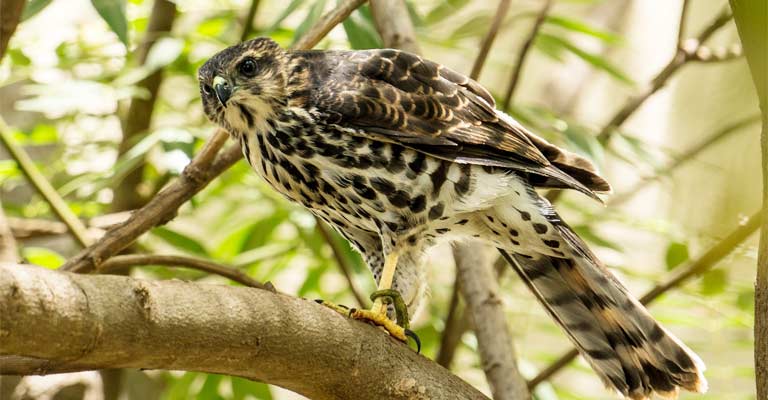
Taxonomy of African Goshawk
Here’s a table detailing the taxonomy of the African Goshawk (Accipiter tachiro):
| Taxonomic Rank | Classification |
| Domain | Eukaryota |
| Kingdom | Animalia |
| Phylum | Chordata |
| Class | Aves |
| Order | Accipitriformes |
| Family | Accipitridae |
| Genus | Accipiter |
| Species | A. tachiro |
This table outlines the hierarchical classification of the African Goshawk, ranging from its broad categorization as a member of the animal kingdom to the specific species designation within the Accipiter genus.
Each taxonomic rank represents a level of biological organization, with the species name combining the genus (Accipiter) and the specific epithet (tachiro) unique to the African Goshawk.
The African Goshawk (Accipiter tachiro) is a species that exhibits notable regional variations, leading to the recognition of three distinct subspecies.
Each of these subspecies showcases unique characteristics and occupies specific geographic regions, contributing to the overall diversity of the species.
Accipiter tachiro tachiro
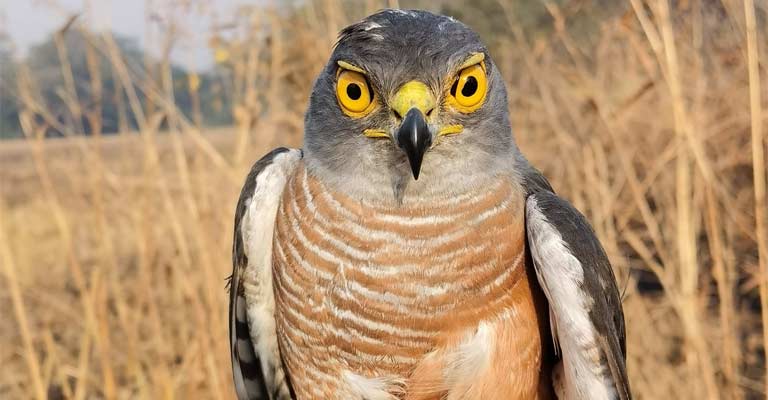
This subspecies is found in the southern regions of Angola, extending through Mozambique and reaching South Africa.
Birds belonging to this subspecies exhibit traits adapted to the environmental conditions prevalent in this part of their range.
The distinctiveness of their plumage, size, and behaviors reflects the evolutionary adaptations to the specific habitats within southern Africa.
Accipiter tachiro sparsimfasciatus
Occupying a range from Somalia to the northern Democratic Republic of the Congo, Angola, Zambia, and Mozambique, this subspecies demonstrates regional variations shaped by the diverse ecosystems it inhabits.
The plumage, size, and perhaps even hunting strategies of Accipiter tachiro sparsimfasciatus may differ from those of its counterparts in other regions, highlighting the species’ adaptability.
Accipiter tachiro pembaensis
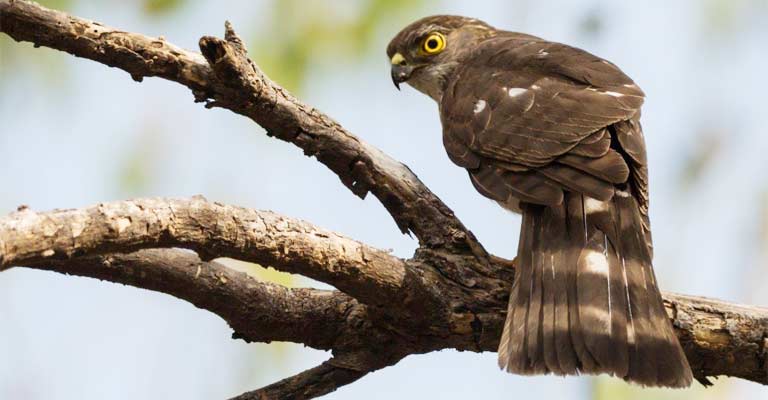
Restricted to the island of Pemba, this subspecies, Accipiter tachiro pembaensis, is uniquely isolated in its habitat. Island environments often contribute to the development of distinct traits in isolated populations, and Pemba is no exception.
The birds on this island likely exhibit specific adaptations that make them well-suited to the conditions found in this particular geographic setting.
Understanding these subspecies provides valuable insights into the ecological and evolutionary dynamics of the African Goshawk.
It underscores the species’ ability to thrive across a range of habitats while adapting to the specific challenges presented by diverse environments.
The recognition of these subspecies enhances our appreciation for the intricate biodiversity within the overarching classification of the African Goshawk, offering a more nuanced perspective on the species’ distribution and adaptation.
Physical Characteristics of African Goshawk
The African Goshawk (Accipiter tachiro) boasts distinctive physical characteristics that facilitate its identification, making it a fascinating subject for bird enthusiasts and researchers alike.
Here are eight key points to aid in identifying this captivating raptor:
Size and Build
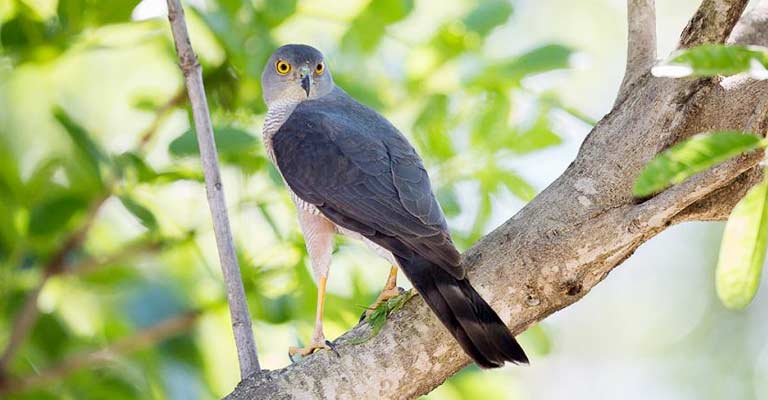
The African Goshawk exhibits a medium-sized build, with males generally smaller than females. On average, they measure between 30 to 46 centimeters (12 to 18 inches) in length.
Their robust bodies and broad wings contribute to their agile and powerful flight, essential for their hunting prowess.
Plumage Coloration
The plumage of the African Goshawk is characterized by a striking combination of dark grays and browns. The upperparts are typically a slate gray, while the underparts range from pale gray to rich rufous-brown.
This coloration aids in camouflage within their diverse habitats, from dense forests to open woodlands.
Distinctive Markings
Notably, the African Goshawk exhibits distinct markings on its plumage. Adults feature a series of dark bars and streaks on their breasts and belly, providing a unique and identifiable pattern.
These markings are particularly pronounced in comparison to other raptors in their range.
Facial Features
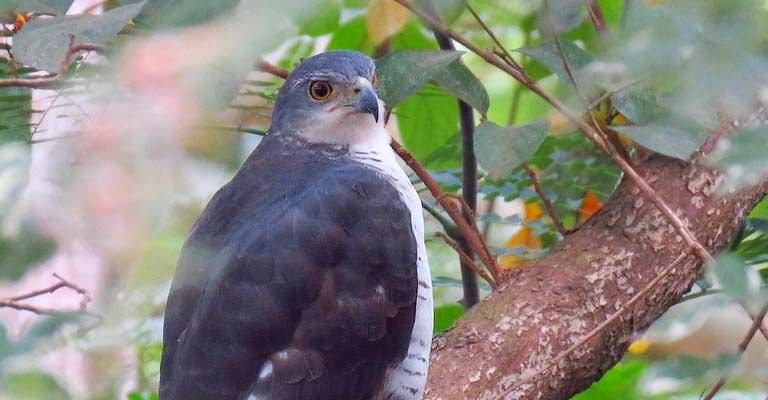
The facial features of the African Goshawk contribute to its charismatic appearance. The bird often sports a prominent, fierce-looking facial mask, marked by dark lines around the eyes and a hooked beak.
The eyes themselves are typically yellow or orange, enhancing the bird’s keen and focused gaze.
Tail Characteristics
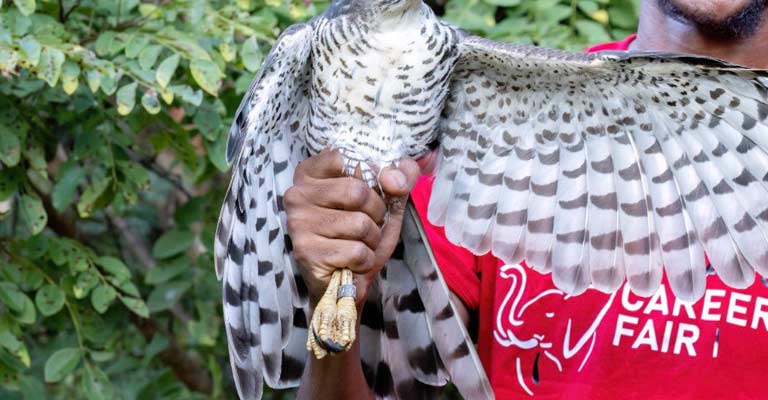
Observing the tail is crucial for identification. The African Goshawk’s tail is relatively long and squared at the tip.
This distinguishes it from other accipiters, which may have more rounded or notched tails. The tail serves as a crucial tool during their acrobatic aerial pursuits of prey.
Sexual Dimorphism
Sexual dimorphism in size is evident in African Goshawks. Females tend to be larger than males, with a wingspan that can reach up to 90 centimeters (35 inches).
This difference in size is particularly noticeable when observing a mating pair or a family group.
Flight Pattern
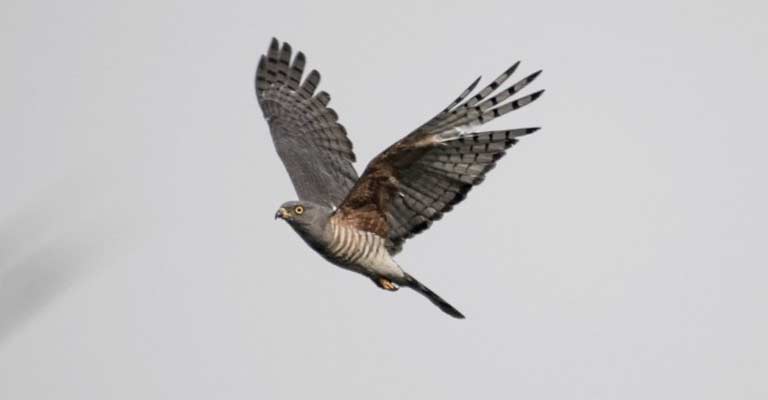
The African Goshawk’s flight pattern is characterized by rapid wing beats interspersed with short glides.
Their agile and maneuverable flight allows them to navigate through dense vegetation in pursuit of prey. Observing their flight behavior can be a key factor in identification.
Recognizing the African Goshawk involves a holistic assessment of its size, plumage, facial features, tail characteristics, sexual dimorphism, flight pattern, and knowledge of its preferred habitats.
This comprehensive understanding enhances the appreciation of this remarkable bird of prey in its natural environment.
African Goshawk Life History
The life history of the African Goshawk (Accipiter tachiro) unfolds as a captivating narrative of adaptation, survival, and ecological interdependence.
This medium-sized raptor, thriving across diverse landscapes of sub-Saharan Africa, intricately weaves its existence into the intricate tapestry of its habitat.
From its dietary preferences and nesting behaviors to its reproductive strategies and the challenges it faces, the life history of the African Goshawk offers a window into the dynamic world of avian ecology.
Food

A skilled and agile predator, the African Goshawk is predominantly carnivorous, preying upon a variety of birds and small mammals. Its diet may include doves, pigeons, small rodents, and occasionally insects.
The bird’s keen eyesight and swift flight make it a formidable aerial hunter, adept at navigating through dense vegetation to capture its prey.
Habitat
The African Goshawk exhibits remarkable adaptability, inhabiting a range of environments from dense forests and woodlands to open savannas.
Its distribution spans southern Angola, Mozambique, South Africa, Somalia, the Democratic Republic of the Congo, Zambia, and Pemba.
This versatility underscores the bird’s ability to thrive in diverse ecosystems, demonstrating a preference for habitats rich in potential prey.
Range Map
A detailed range map illustrates the extensive distribution of the African Goshawk across sub-Saharan Africa.
Its presence is marked by distinct subspecies in various regions, each adapted to the unique conditions of its specific habitat.
This map serves as a valuable tool for researchers and conservationists seeking to understand the bird’s geographic range and plan conservation efforts accordingly.
Nesting

The African Goshawk is known for its discreet and well-concealed nests. Typically constructed in the forks of trees, the nests are composed of sticks and lined with softer materials such as leaves or feathers.
This strategic placement helps protect the eggs and chicks from potential predators while providing a secure vantage point for hunting.
Here’s a table detailing nesting details of the African Goshawk (Accipiter tachiro):
| Nesting Details | Facts |
| Clutch Size | Typically 2 to 4 eggs per clutch |
| Number of Broods | Usually 1 brood per breeding season |
| Egg Length | Approximately 38 to 50 mm (1.5 to 2 inches) |
| Egg Width | Around 30 to 38 mm (1.2 to 1.5 inches) |
| Incubation Period | Approximately 30 to 35 days |
| Nestling Period | Approximately 30 to 40 days |
| Egg Description | Oval-shaped with a variable background color, often pale blue or white, marked with spots or blotches. |
| Nest Construction | Constructed with sticks and lined with softer materials like leaves or feathers |
| Nest Placement | Typically located in the forks of trees, well-concealed for protection |
| Parental Involvement | Both males and females contribute to incubation and feeding |
| Nest Site Selection | Strategic placement provides a secure vantage point for hunting and protects eggs/chicks from predators |
Breeding
Breeding in the African Goshawk occurs during specific seasons, varying across its range. Mating pairs engage in elaborate courtship displays, reinforcing their bond.
The female lays a clutch of eggs, and both parents share the responsibilities of incubation and feeding the chicks. This collaborative approach enhances the chances of reproductive success.
Diseases
Like many bird species, the African Goshawk may be susceptible to various diseases, including those transmitted by parasites.
Avian diseases can impact the health and reproductive success of populations, necessitating vigilant monitoring and research to understand and mitigate potential threats.
Treatment
Efforts to treat diseases in the African Goshawk involve a combination of veterinary care, research into disease dynamics, and habitat management.
Rehabilitation and conservation programs may be initiated to address specific health challenges, ensuring the well-being of individual birds and the sustainability of populations.
Conservation
Conservation initiatives for the African Goshawk focus on preserving its habitats, understanding and mitigating potential threats, and fostering sustainable coexistence with human activities.
Habitat preservation, legal protections, and community involvement are crucial elements in ensuring the continued survival of this remarkable raptor.
The life history of the African Goshawk is an intricate tale of ecological resilience, highlighting the interconnectedness of its biology with the diverse landscapes it calls home.
As stewards of these ecosystems, our understanding and conservation efforts play a pivotal role in safeguarding the future of this fascinating bird species.
10 Fun Facts About African Goshawk
The African Goshawk (Accipiter tachiro) is a remarkable bird of prey that captivates enthusiasts and researchers alike with its intriguing behaviors and adaptations. Here are 10 fun facts about this enigmatic raptor:
- Agile Hunters: African Goshawks are renowned for their exceptional agility in flight. They navigate through dense vegetation with remarkable precision, making them skilled hunters in various environments.
- Size and Sexual Dimorphism: Males are generally smaller than females, showcasing a classic example of sexual dimorphism. The size difference is particularly noticeable during courtship displays and when observing mating pairs.
- Varied Plumage: The plumage of African Goshawks displays a stunning blend of dark grays and browns, providing effective camouflage in their diverse habitats. This intricate coloration, coupled with distinctive markings, makes them visually captivating.
- Distinct Subspecies: The species comprises three recognized subspecies, each adapted to specific geographic regions. This variation highlights the bird’s ability to thrive in diverse ecosystems across sub-Saharan Africa.
- Courtship Displays: Mating pairs engage in elaborate courtship displays, involving aerial acrobatics and vocalizations. These displays strengthen the bond between partners and contribute to successful breeding.
- Nesting Strategies: African Goshawks construct well-concealed nests using sticks and line them with softer materials like leaves or feathers. Nest placement in tree forks provides a strategic vantage point for hunting and protects eggs and chicks from predators.
- Rapid Reproduction: The species typically produces one brood per breeding season, with clutch sizes ranging from 2 to 4 eggs. This reproductive strategy contributes to the species’ ability to maintain populations in dynamic environments.
- Swift Incubation: Incubation periods for the eggs last approximately 30 to 35 days. Both males and females share the responsibilities of incubation, emphasizing collaborative parenting.
- Skilled Predators: African Goshawks primarily feed on birds and small mammals, showcasing their prowess as aerial predators. Their keen eyesight and swift flight contribute to successful hunting ventures.
- Adaptable Habitat: From dense forests to open woodlands and savannas, the African Goshawk displays adaptability to various habitats. This adaptability allows the species to thrive across a broad geographic range.
The African Goshawk is not only a masterful hunter and adept parent but also a species that adds a vibrant tapestry of biodiversity to the African landscape. Studying these fun facts enhances our appreciation for the intricate lives of these captivating birds of prey.
Wrapping Up
The African Goshawk emerges as a fascinating avian species, blending agility, adaptability, and captivating behaviors across its varied habitats.
From the intricate details of nesting and courtship to its remarkable hunting prowess, the bird’s life history underscores its vital role in the ecological tapestry of sub-Saharan Africa.
Recognizing the distinct subspecies, understanding their behaviors, and acknowledging conservation needs are essential steps toward ensuring the continued presence of this enigmatic raptor.
By delving into the world of the African Goshawk, we gain not only insights into avian biology but also a deeper appreciation for the interconnectedness of all species in their natural environments.